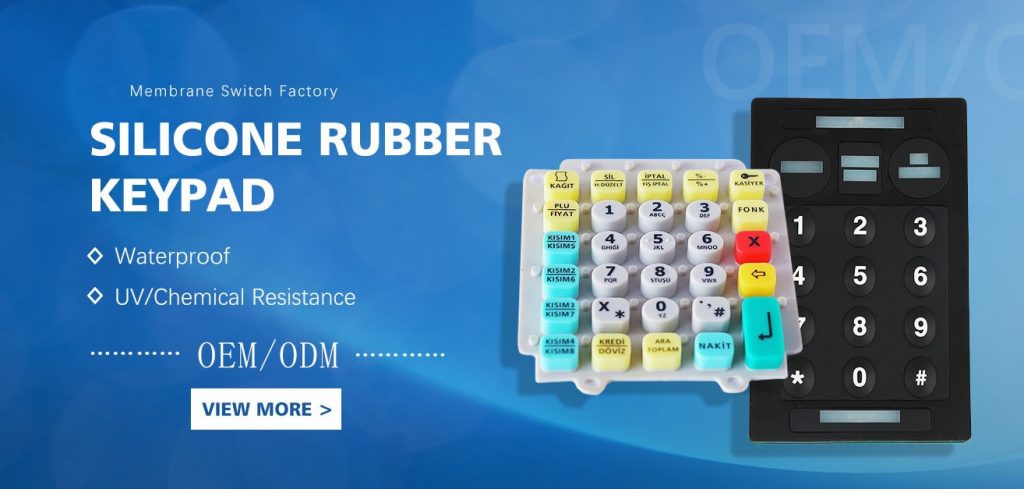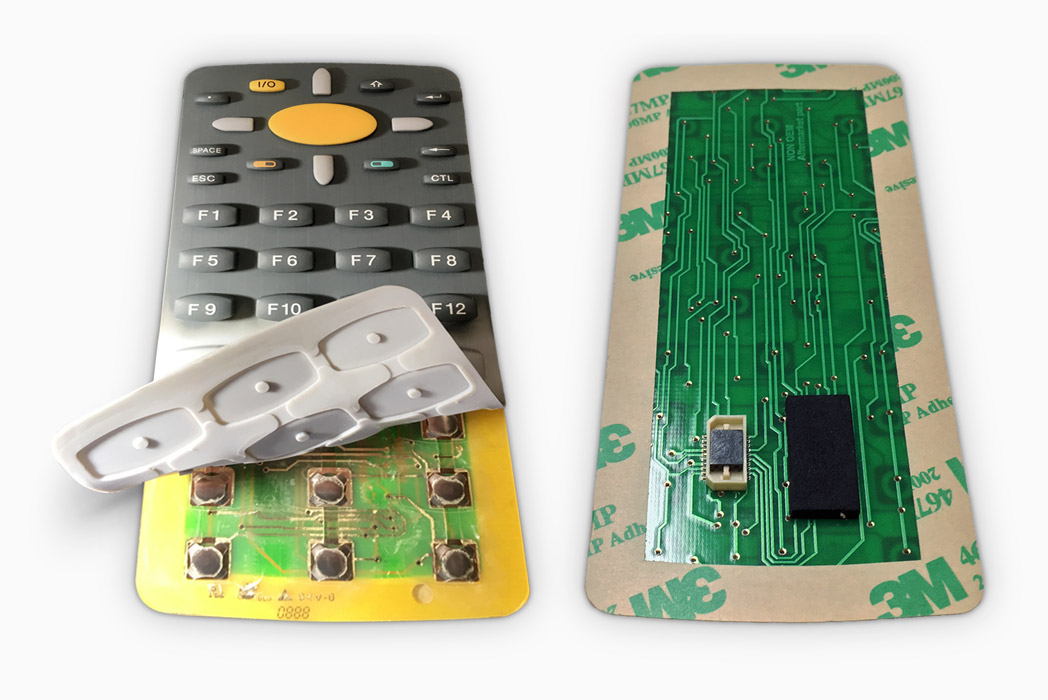A Comprehensive Overview to the Manufacturing and Handling of Rubber Keypads for Ideal Efficiency
The production and processing of rubber keypads play an essential duty in their performance and usability. Product selection, style precision, and sophisticated manufacturing methods considerably influence their sturdiness and effectiveness. Recognizing these components is crucial for developing premium items. As different developments emerge in this area, exploring their ramifications might reveal new standards for functionality and customer experience. What vital facets will shape the future of rubber keypads?
Recognizing Rubber Keypads: Materials and Types
Rubber keypads are vital parts in plenty of tools, providing a balance of longevity and tactile feedback. These keypads are largely made from silicone or synthetic rubber, products picked for their versatility and durability. Silicone rubber, particularly, is favored for its exceptional temperature level resistance and longevity, making it ideal for different applications, from customer electronics to industrial equipment.
There are numerous types of rubber keypads, consisting of dome button keypads, which use a dome-shaped system that provides responsive responses when pressed. Furthermore, there are also level keypads, which feature a smooth surface and are typically utilized in clinical gadgets and remote controls. The choice of material and kind influences the keypad's performance, feel, and overall individual experience. Comprehending these facets is crucial for makers and developers intending to develop effective and reliable user interfaces in their items.
The Production Process: From Design to Production
The production process of rubber keypads involves numerous important stages, starting with layout and finishing with manufacturing. Initially, developers develop comprehensive specs and models, guaranteeing the keypad fulfills visual and practical needs. Computer-aided style (CAD) software program is commonly utilized to imagine the design and features prior to proceeding.
Once the layout is completed, product option is vital, with options generally including silicone or all-natural rubber. In the following phase, molds are produced based on the approved designs, which will certainly shape the keypads during production.
Following mold and mildew development, the production phase commences, where rubber is mixed with additives to boost performance. The blend is after that put into mold and mildews and subjected to warmth and pressure, enabling it to heal and solidify.
The completed keypads undertake top quality checks to validate they satisfy recognized standards, followed by product packaging for circulation. This all-encompassing process assurances peak performance in the end product.
Secret Methods in Rubber Molding
In the domain of rubber keypads, numerous molding methods play a crucial role in establishing the high quality and capability of the final product. One common method is compression molding, where raw rubber is positioned in a heated mold and mildew and pressure is applied, permitting effective automation and uniformity. An additional considerable method is injection molding, which entails injecting warmed rubber right into a mold and mildew, offering better precision and complex shapes. Transfer molding, a crossbreed of both methods, is also made use of, especially for detailed layouts, as it incorporates the benefits of both procedures. Additionally, liquid silicone rubber (LSR) molding is gaining traction due to its adaptability and durability, making it ideal for high-performance applications. Each technique possesses one-of-a-kind characteristics, influencing aspects such as cycle time, product waste, and manufacturing expenses. Picking the appropriate molding technique is essential for attaining peak efficiency in rubber keypads.
Surface Finishing and Texturing Options
Surface area completing and texturing choices play an essential role in enhancing the tactile experience and aesthetic allure of rubber keypads. Producers utilize numerous techniques to create distinct surface characteristics that affect customer communication and product design. Common finishing techniques include matte, glossy, and satin surfaces, each providing various aesthetic effects and grip levels. Texturing alternatives, such as raised patterns, grooves, or stippling, further boost functionality by enhancing grip and decreasing slippage throughout usage.
In addition, certain appearances can be customized to meet ergonomic demands, giving comfort during long term usage. The option of surface area finishes and structures can be affected by the designated application of the keypad, whether it be for customer electronics, automobile controls, or industrial devices. Ultimately, mindful consideration of these choices adds substantially to customer complete satisfaction and general product efficiency, making them essential elements in the design and manufacturing process of rubber keypads.
Top Quality Control Actions in Rubber Keypad Manufacturing
Quality control steps in rubber keypad production are important for guaranteeing product integrity and efficiency. These steps include material selection requirements, strenuous testing procedures, and rigorous final evaluation standards. Together, they develop an extensive framework that aids suppliers copyright high quality throughout the production process.

Product Option Criteria
Picking the suitable products for rubber keypads is crucial, as it directly affects their sturdiness, capability, and customer experience. Key standards for product selection consist of tensile strength, resilience, and ecological resistance. The option of rubber compound, such as silicone or thermoplastic elastomer (TPE), plays an important function in achieving preferred responsive comments and longevity. Furthermore, variables like chemical compatibility, temperature level stability, and UV resistance have to be taken into consideration to assure optimal efficiency in various applications. Suppliers should also review the ease of processing and cost-effectiveness of materials, stabilizing top quality with budget restrictions. Inevitably, the ideal product choice not only enhances the keypad's performance but additionally adds to general item quality and customer satisfaction.
Examining Treatments Carried Out
After establishing the suitable products for rubber keypads, rigorous screening procedures are implemented to confirm that the final products fulfill sector criteria and customer assumptions. These procedures normally consist of mechanical testing, which reviews the toughness and flexibility of the rubber under numerous conditions. Furthermore, ecological screening evaluates the keypads' efficiency under temperature level variations, humidity, and exposure to chemicals. Electric screening validates the keypads function correctly with digital parts, validating responsiveness and conductivity. Furthermore, responsive comments is assessed to guarantee individual complete satisfaction. These extensive screening actions are important in determining any disparities or defects before mass manufacturing, inevitably enhancing the integrity and performance of rubber keypads read more in their desired applications.

Last Assessment Specifications
Extensive final evaluation standards are crucial in rubber keypad manufacturing to assure that each unit satisfies the defined criteria for capability and look. This process typically involves aesthetic evaluations to identify any surface defects, such as discoloration or imperfections. Furthermore, tactile examinations identify that the keypads react accurately to touch, preserving the called for degree of level of sensitivity. Resilience tests may likewise be performed, replicating prolonged site here usage to validate the long life of the keypad under various conditions. In addition, adherence to industry guidelines and client specifications is validated to maintain quality control. By implementing these strenuous inspection measures, makers can substantially minimize the danger of issues, making sure that the final item is reliable and fulfills customer expectations, inevitably improving consumer fulfillment.
Advancements in Rubber Keypad Modern Technology
As modern technology continues to evolve, developments in rubber keypad modern technology are reshaping interface across different industries. One considerable advancement is the assimilation of capacitive touch sensing units within rubber keypads, permitting for a more versatile and receptive individual experience. This technology allows users to interact with devices with touch, boosting functionality without sacrificing the tactile responses that rubber keypads are understood for.
Furthermore, renovations in material solutions have actually resulted in the development of more long lasting, weather-resistant rubber, making keypads ideal for commercial and outside usage. Boosted printing methods likewise enable high-resolution graphics and backlighting options, increasing visibility and visual appeal.

Improvements in manufacturing processes, such as 3D printing, are enabling personalized layouts and quick prototyping, enhancing manufacturing timelines. These developments collectively add to much more easy to use and efficient rubber keypads, ensuring they fulfill the needs of contemporary applications while preserving their core advantages.
Ideal Practices for Style and Capability
Designing efficient rubber keypads requires cautious assessment of both aesthetic appeals and functionality. Rubber Keypads. A properly designed keypad needs to stabilize ergonomic concepts with visual interest boost user experience. Trick factors consist of dimension, form, and spacing of buttons, ensuring they are simple to press while preventing unintentional activation. Making use of contrasting colors and appearances can boost presence and responsive comments, aiding customers in comparing secrets
In addition, the selection of products plays a vital function; high-grade rubber substances can improve toughness and resistance to put on. It is additionally important to take right into account the assimilation of functions such as backlighting and customized graphics, which can boost usability in numerous environments.
Finally, prototyping and customer screening are important in the design process, permitting for modifications based upon real-world comments. Homepage By sticking to these best techniques, producers can produce rubber keypads that not only look attractive yet also satisfy the functional requirements of customers properly.
Regularly Asked Concerns
How Do I Pick the Right Rubber Product for My Keypad?
To choose the best rubber material for a keypad, one must think about factors such as resilience, ecological resistance, tactile responses, and compatibility with the intended application, ensuring optimal performance and individual contentment in different problems.
What Are the Environmental Impacts of Rubber Keypad Manufacturing?
Rubber keypad manufacturing can bring about environmental impacts such as deforestation for natural rubber sources, air pollution from chemical processes, and waste generation. Sustainable techniques and products can minimize a few of these adverse effects on communities.
Can Rubber Keypads Be Recycled or Recycled?
Rubber keypads can be reused, but the process relies on the details products utilized in their production. Reusing them in various applications is likewise feasible, adding to lose decrease and advertising sustainability in producing practices.
What Is the Ordinary Lifespan of a Rubber Keypad?
The average life-span of a rubber keypad usually varies from 5 to ten years, depending upon usage, ecological aspects, and maintenance. Normal treatment can extend its performance, while excessive wear may reduce its durability.
Are There Any Wellness Worries Associated With Rubber Keypad Materials?
There are possible health and wellness problems connected to rubber keypad materials, including sensitive responses to certain chemicals and toxic irritants used in production. Correct handling and awareness of material composition can reduce these risks for users.
There are several kinds of rubber keypads, including dome switch keypads, which make use of a dome-shaped mechanism that gives tactile comments when pushed. Choosing the appropriate materials for rubber keypads is essential, as it directly influences their functionality, toughness, and individual experience - Rubber Keypads. After determining the proper materials for rubber keypads, strenuous screening treatments are applied to verify that the last products satisfy sector standards and client assumptions. Rubber keypad production can lead to environmental effects such as logging for all-natural rubber sources, contamination from chemical procedures, and waste generation. Rubber keypads can be recycled, however the procedure depends on the details materials utilized in their production